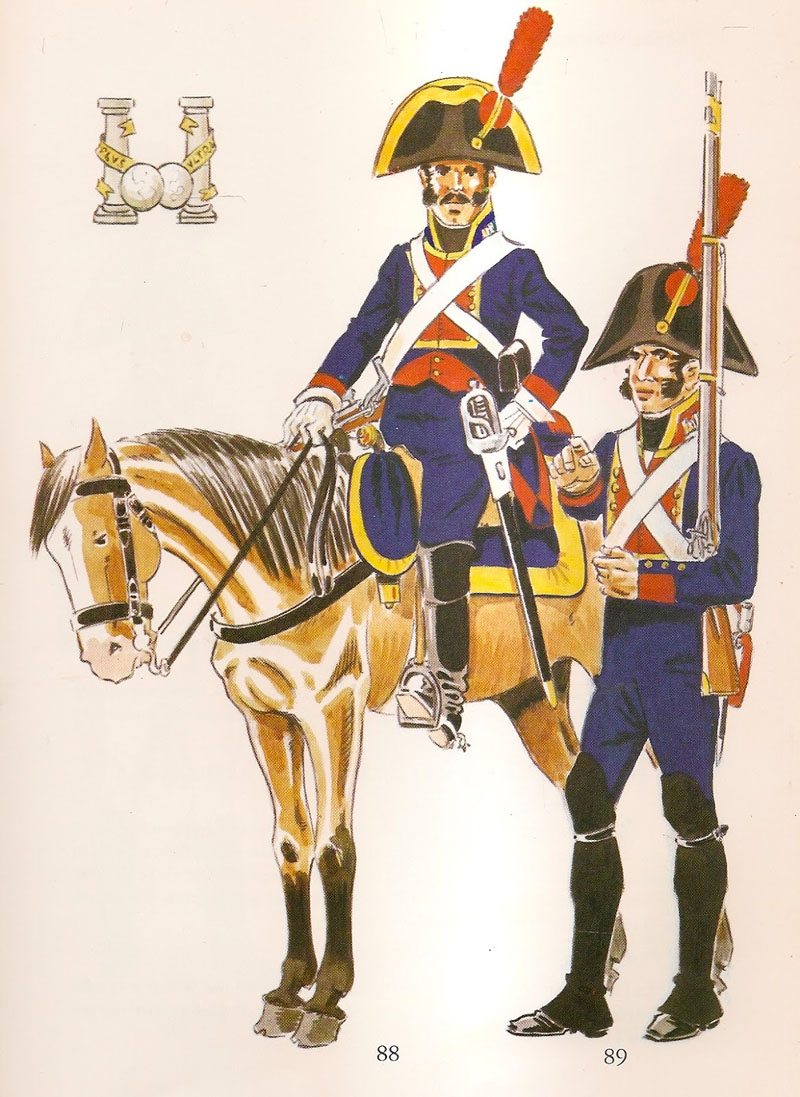|
Tercios de TejasOrganisationThe Corps of Texas Spanish Tercios (Tercios Españoles de Tejas) hereafter referred to as the Tercios de Tejas was an expeditionary corps raised in Spain by Brigadier don Pedro Grimarest starting 6 August 1804 being destined for the province of Texas. However in 1808 it still remained in the Peninsula located at Cadiz. They never reached Texas. The Tercios de Tejas were to made up of four light infantry and four cavalry tercios, each of 3 companies. It was actually formed as two light infantry battalion-like tercios and (probably) two cavalry squadron-like tercios. The infantry were in combat at Menjibar on 16th July 1808 and Bailen on 19th July 1808 with a strength of 436 men as part of Lt General Teodoro Reding's 1st Division. On 12th August 1808 one tercio was converted to the Batallon de Cazadores de Bailen and the other to Batallon de Cazadores de Las Navas de Tolosa. The cavalry served at Uclés on 13th January 1809 with a strength of 15 officers and 153 troopers. They were later renamed the Cazadores de Sevilla. UniformsThe uniforms and equipment of the Tercios de Tejas were of the same model as the line infantry and line (heavy) cavalry, differing only in the colour. The collar badge consisted of the two Hemispheres and the Pillars of Hercules in silver with gold scrolls. InfantryThe infantry uniform was a dark blue long-tailed coat with facing colours (collars, cuffs, lapels and turnbacks) in red. Unusually Bueno shows the cuff flaps as blue rather than the facing colour which could have been expected. Buttons were brass and yellow lace edged the collar and lapels. The waistcoat was red. Breeches were dark blue and the knee length gaiters were black. The headgear was a black felt bicorn with the red Spanish cockade and red plume. The infantry were armed with a musket and bayonet. Sergeant would have had an additional short sword. Officers: Nothing is known about the officers' uniform, but it could be expected to be the same style as that of the private but better quality, worn with epaulettes in gold, a gilt gorget and boots rather than gaiters. Drummers: Nothing is known about the drummers' uniform, but if it followed the normal Spanish practice, it could be expected to be the same as that of the private but with red and white lace. CavalryThe cavalry uniform was a dark blue long-tailed coat with facing colours (cuffs, lapels and turnbacks) in red. Buttons were brass and yellow lace edged the collar and lapels. The waistcoat was red. Breeches were dark blue, worn with black long cavalry boots. The headgear was a black bicorn, edged yellow with the red Spanish cockade and red plume. The cavalry were armed with a straight sword, two pistols and a carbine. The carbine was secured by a hook to the carbine belt hung over the left shoulder. Sergeants did not carry the carbine. Officers: Nothing is known about the officers' uniform, but it could be expected to be the same style as that of the trooper but better quality, worn with epaulettes in gold. Trumpeter: Nothing is known about the trumpeters' uniform, but if it followed the normal Spanish practice, it could be expected to be the same as that of the private but with red coat, yellow or red facings and red breeches.
FlagsThe Royal Decree of 1802 set the number of flags to one per infantry battalion. These were of the 1762 pattern. Whether the 2 battalions of the Tercios de Tejas carried such flags is unknown. Sources
|


